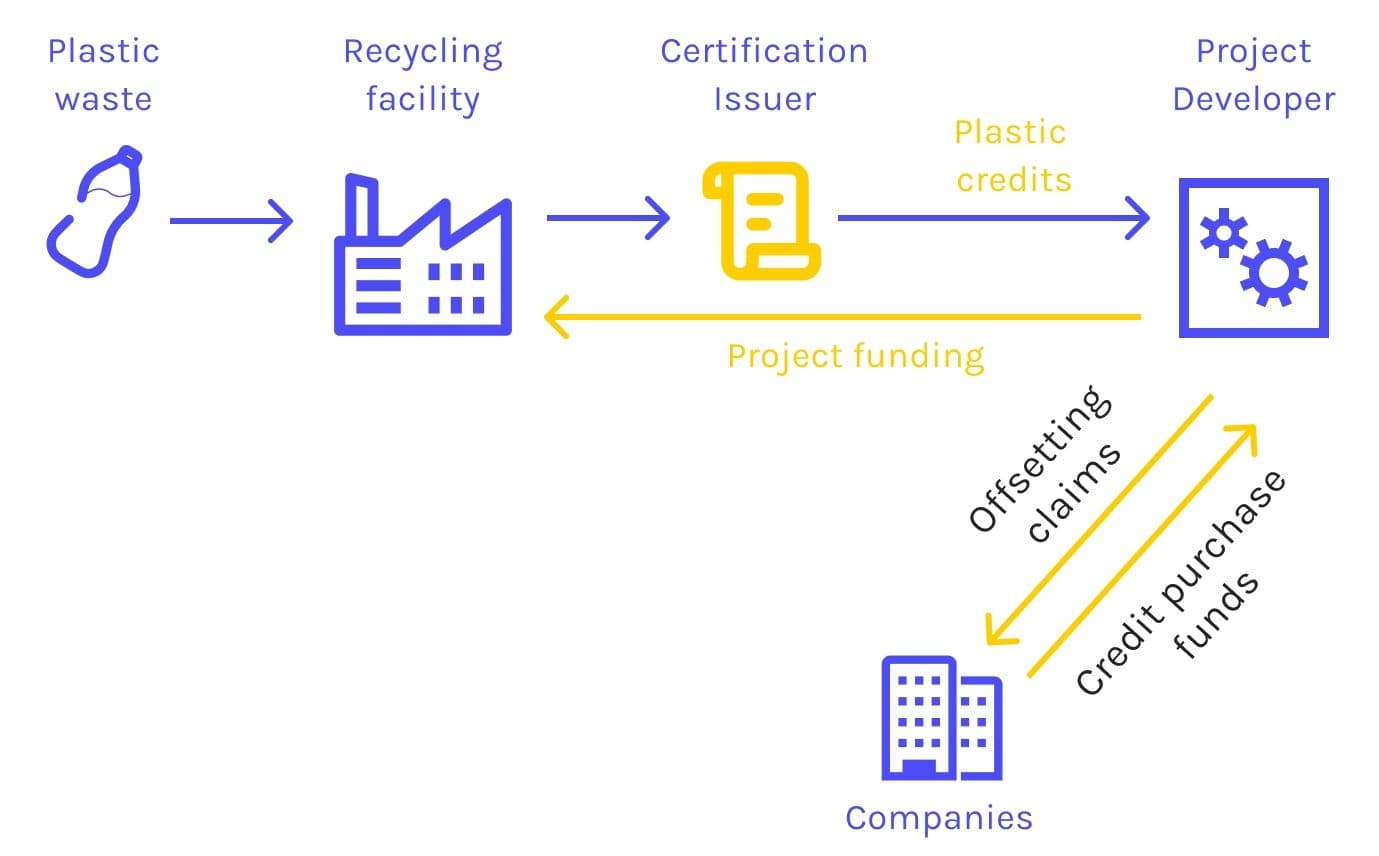Plastic waste has become an increasingly pressing environmental concern, with its detrimental effects reaching far and wide. From choking our oceans and harming marine life to polluting our soil and endangering human health, the impact of plastic waste cannot be understated. A 2016 World Economic Forum report indicates that without concrete action, there may be more plastic than fish in the ocean, by weight, by 2050.
As the global population continues to produce and consume plastic at an alarming rate, exploring innovative solutions to address this crisis is crucial. One such solution gaining traction is the concept of plastic credits.
What is plastic credit?
Plastic credits represent an innovative way of tackling the plastic problem. Plastic credits are issued by organizations that help collect or recycle additional plastic waste. The amount of plastic waste collected or recycled is verified by a third party, and then a plastic credit is issued for a specified unit of plastic waste collected or recycled.
The concept of “additionality” is important in plastic credits. To earn plastic credits, it must be proven that the plastic collected or recycled would otherwise not have been collected without the effort. Thus, additionality helps ensure that the impact of plastic credits goes beyond mere token gestures and leads to tangible environmental benefits.

By requiring activities supported by plastic credits to be additional and beyond business-as-usual practices, additionality ensures that the credits drive genuine change and result in a measurable reduction in plastic waste. This criterion prevents the system from being exploited or diluted by actions that would have occurred regardless of the credit system.
How can plastic credits be an interesting measure to solve plastic pollution?
Plastic credits are necessary because plastic waste has become a global environmental crisis. Every year, millions of tons of plastic end up in our oceans, landfills, and ecosystems, causing significant harm to wildlife, polluting water sources, and disrupting natural ecosystems. OECD data shows that from 2000 to 2019, global plastics production doubled to reach 460 million tonnes. Plastics account for 3.4% of global greenhouse gas emissions.
)](/_next/image?url=https%3A%2F%2Fstorage.googleapis.com%2Ftocco-cms%2FOECD_Plastic_pollution_432ec0f2ea%2FOECD_Plastic_pollution_432ec0f2ea.png&w=2048&q=75)
The scale and impact of plastic pollution demand immediate action. In this regard, Plastic credits help ensure that less plastic gets dumped in unmanaged systems. Plastic credits provide a solution by creating a structured framework to incentivize and reward efforts in reducing plastic waste.
They encourage individuals, businesses, and organizations to actively address the problem by adopting sustainable practices and supporting initiatives promoting responsible plastic management. Ultimately, it helps organizations achieve plastic neutrality faster.
These credits serve as a measurable way to track and quantify the positive impact of actions taken to reduce plastic waste. By assigning a value to these efforts, plastic credits establish a system where individuals and organizations can earn credits for recycling, reducing single-use plastics, supporting clean-up initiatives, or investing in innovative solutions.
Plastic credits: how do they work?
Various organizations issue plastic credits, and it is important to only acquire these credits from reputable organizations. Some of the biggest plastic credit programs are run by organizations like Verra, rePurpose Global Inc, Zero Plastic Oceans, and Plastic Credit Xchange.
While all these organizations offer plastic credits, their modus operandi differ. Let’s take a look at each to better understand how they work.
Verra
Verra offers a Plastic Program made up of two components — Waste Collection Credits and Waste Recycling Credits.
- Waste Collection Credits are issued to projects that verifiably dispose of the collected plastic waste in an end destination that prevents it from leaking into the environment.
- Waste Recycling Credits are issued to projects that demonstrate they have recycled plastic into a feedstock that can displace the use of virgin plastic.
With Verra, a plastic credit represents one metric tonne of plastic waste collected or recycled. The plastic credits are issued based on the volume of plastic collected and recycled above baseline rates. This means the credits are only issued for the volume of plastic that would have been disposed of improperly or ended up as pollution if it weren't for the actions supported by the credits.
To ensure accountability, Verra has quality assurance principles in place for the Plastic Program. In addition, all records of plastic credit issuance and retirement can be publicly accessed via the Verra Registry.
rePurpose Global Inc
rePurpose Global Inc’s plastic credit scheme aims to collect plastic from nature-bound sources. The collected plastics are recycled, and the remaining ones get passed to the next most environmentally-friendly end-of-life management solution.
With rePurpose Global Inc, a certified plastic credit is issued for each additional kilogram of plastic recovered or recycled by an impact project. Businesses can also get rePurpose’s flagship Plastic Neutral Certification. The certification shows that the business purchases the plastic credits equivalent to the removal or recycling of plastic waste that they generate each year.
Zero Plastic Ocean
Created in 2019, Zero Plastic Ocean focuses on ocean-bound plastic (OBP) waste. OBP is a type of plastic waste defined as “at risk of ending up in the ocean.” The organization offers an ocean-bound plastic certification comprising the Ocean Bound Plastic Recycling Certification Subprogram and the Ocean Bound Plastic Neutrality Certification Subprogram.
The Ocean Bound Plastic Recycling Certification Subprogram asserts the source of OBP waste from where it was first collected and traces the OBP waste till a new product is made out of it. The OBP Collection Organization Standard and the OBP Recycling Organization Standard are used to certify the entire value chain.
The Ocean Bound Plastic Neutrality certifications target non-commercially recyclable OBP waste. The OBP Neutrality certifications allow organizations collecting and treating non-recyclable OBP waste to issue and sell third-party verified plastic credits.
Plastic Credit Xchange
PCX helps certify plastic neutrality through plastic credits. Businesses can make simple offsets based on weight if they are not ready to fully commit to plastic neutrality. Those willing can earn PCX’s plastic neutrality badge by purchasing plastic credits to remove the past year's verified plastic footprint plus two years moving forward.
Downsides of plastic credits
While plastic credits can potentially incentivize and reward positive actions related to plastic waste, it has some downsides. To start with, the plastic credits market is not sufficiently regulated or standardized. In a paper published by the Deutsche Gesellschaft für Internationale Zusammenarbeit, it was noted that the plastic market is convoluted because the various schemes differ in their standards and processes.
Furthermore, plastic credit is more of a defensive strategy. It doesn't effectively stop the production of plastic from the source. Instead, the focus is cleaning up existing plastic waste and encouraging proper management practices. While plastic credits contribute to mitigating the environmental impact of plastic waste, they do not directly address the issue of plastic production. The primary goal is to reduce the amount of plastic that enters our ecosystems and landfills by promoting the use of more environmental-friendly materials.
Some companies or organizations may use plastic credits as a marketing tool without making substantial efforts to reduce their overall plastic footprint. This can undermine the integrity of plastic credits and dilute their effectiveness as a genuine solution to plastic pollution.
Final thoughts
Plastic credits represent a commendable and innovative approach to mitigating the environmental impact of plastic waste. They offer a tangible way to incentivize and reward actions that reduce plastic pollution and promote responsible plastic management.
However, it is important to recognize that plastic credits are still in their early stages, and their effectiveness is contingent upon several factors, including regulation, standardization, and widespread adoption. While they can help keep plastics out of the environment and promote sustainable practices, they do not address the fundamental issue of excessive plastic production.
The most effective and sustainable approach to tackling the plastic crisis is to bring the production of fresh plastic to a minimal level. This requires comprehensive strategies that encompass reduction at the source, development, and adoption of sustainable alternatives to plastics, and the promotion of circular economy practices.
💡Download our Plastic Glossary here to understand (almost) everything about plastics
References
Deutsche Gesellschaft für Internationale Zusammenarbeit (GIZ) GmbH. (2022). Position paper of the sectoral department on plastic credits. https://www.giz.de/expertise/downloads/giz2022-en-position-paper-plastic-credits.pdf
Plastic pollution is growing relentlessly as waste management and recycling fall short, says OECD. (n.d.). https://www.oecd.org/environment/plastic-pollution-is-growing-relentlessly-as-waste-management-and-recycling-fall-short.htm
World Economic Forum. (2016). The New Plastics Economy Rethinking the future of plastics. https://www3.weforum.org/docs/WEF_The_New_Plastics_Economy.pdf








